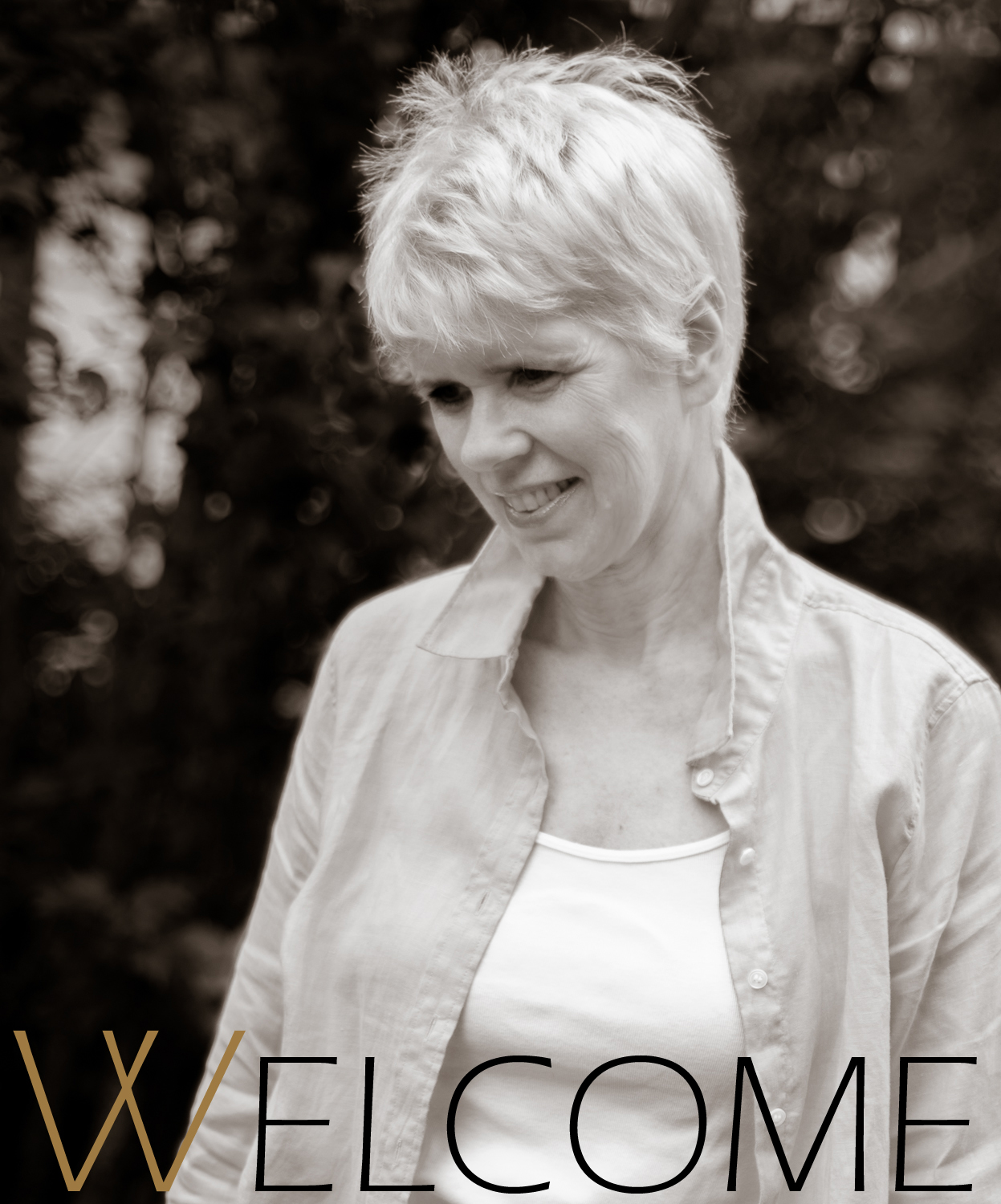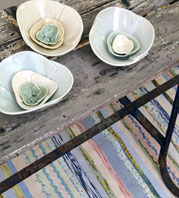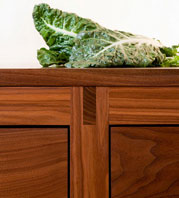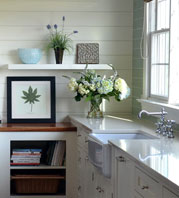Gimmeshelter Project - Join Us On The Journey!
I meant to formally introduce/announce this fantastic project before now, but at this moment, I want to enlist your help in making a decision on the interior of an inspiring house that I am working on. First, a bit about the project...
Leslie Hoffman, Executive Director of Earth Pledge is taking innovative green building and reuse philosophies to a new level with her current project, and personal residence, a modern beach house on bucolic Shelter Island, nestled between the twin forks of eastern Long Island. The project, named GimmeShelter, brings together a team of passionate green building professionals, led by Leslie's decades long commitment to sustainable living. The products used in this home represent the latest green technology, information on which Leslie is particularly eager to share in an effort to inform and educate. The GimmeShelter project introduces a new dimension of community to a single residential home, supporting new thinking in indoor/outdoor living. I will talk much more about this project in the coming weeks and months. I'm thrilled and honored to be a part of this project. It's pretty awesome.

I went out to the site to meet Leslie (in a huge nor'easter-60mph winds, anyone?) to take a look at a ceiling issue that Leslie needs to make a decision on right away. Design is, and must be, a collaborative process. So, we put it up for discussion, in the spirit of community, one of Leslie's defining personal philosophies. The kitchen plays an important role in this issue.
The issue is this: The angled/pitched ceiling line can be built so that it follows through the entire space, from one side to the other, the entire space having a pitched ceiling, ending on the kitchen wall...or not. Each ending wall would have a triangular shape, formed by the pitch of the ceiling. You can see this natural roof pitch on one end of the space, on the wall directly opposite the big green square section of wall.
One issue to consider is that there will be a wall of 8' tall doors, situated below the start of this higher wall (seen in green), extending to the exterior wall at the front of the house (toward the right of the image). The doors will be made of American walnut in a natural finish, harvested locally to the manufacturer. This "wall" of walnut is a strong visual element.
While the entire space is light filled with high ceilings, my concern lays with this wall of walnut being "heavy" on one end. Therefore, I would lean toward NOT continuing the natural slope of the ceiling all across the space. Given that there are walls of glass at the front and rear of the house, another theory might support a lower ceiling in order to "see" the interiors and their outdoor spaces in a more horizontal, rather than vertical, plane. The walnut "wall" of doors in the kitchen may, then, appear somewhat heavier.
Please tell us what you think about this issue. What would you do? Should the angled wall above Leslie in the last image be constructed to go all the way across the room to the other side? BE A FAN OF THE GIMME SHELTER GROUP ON FACEBOOK

Below: the wall directly opposite the square green wall on the other side of the room 



















 Wednesday, March 17, 2010 at 08:58PM
Wednesday, March 17, 2010 at 08:58PM

Reader Comments (30)
What does the architect think? ;-)
It is difficult to understand the specific condition.... but,
I love high ceilings and natural light sourced from above, but the scale of the room needs to be appropriate for what's going on in the space. Also, if the ceiling looks "awkward" with the multiple slopes, adding a lower ceiling may clean up the condition.
Just my 2 cents :-)
Mark, that was the very first conversation we had on the site...Leslie described the architect's vision and reasons surrounding it. Although this tall square wall was not planned to be fully exposed, the architect prefers it that way.
Susan has done a good job describing the situation in words and pictures. My basic concern was that the ceiling would appear to be 'busy,' complicated, and would ultimately just be a distraction from the view. Now, this view is pretty good, so it's a strong pull, but I was imaging sitting in the living room with some guests and everyone looking up rather than out!
I felt that it was important to enlist Susan's help in resolving this question, as it will impact the feeling in the space where the kitchen she has designed will be one of the central features. This large living space houses the kitchen, dining and living spaces, and also serves as the center of the axis of the house in both directions. There are bedrooms off of the Big Room in both directions, and the entry wall of glass onto courtyard and the water side wall/porches are on the other side. All to say that this space is entered, used, sat it, walked through, worked in, eaten in, cleaned in, you name it.
So the feel of this big room is all important. I wanted Susan's opinion before I dwarfed her kitchen. She and her husband braved a nor'easter to come out and have a look. Sebatian Bliss, the carpenter, stopped by and joined the discussion. Susan mentioned that Steve Hoffman, the architect, prefers to show the valley and sheetrock the actual roof planes rather than simplifying it. I hope he jumps in, but the basis of his leaning is that it indicates a connection between the outside shape and the inside shape. A sort of "true to form" idea.
Susan's idea to throw this open for discussion is great, and we all welcome the dialogue. thank you.
There is another consideration - there is an 8' 'line' that is defined by 2 dropped ceilings, 3 large sliding doors, and the top of the kitchen doors. Does this volume above the line, so to speak, pull your high up too much? And also - how to light this volume? I am reluctant to hang anything on that large rectangular wall above 8' (although please correct me if you think I am being too timid), so it seems that lighting is crucial.
sorry - your eye - not high
What a fabulous house! The view must be spectacular as well. I was looking at the photos and the last photo looks like the ceiling might angle up in two 90 degree angles as opposed to sloping up in one direction. So, will the ceiling vault in two directions from that beam or just one 90 degree angle. Also will it vault toward the front of the house or in the direction of the water. If you see the vaulted ceiling as you look out at the water, it will compete with the view and draw the eyes up. On the other hand, if you are standing in the house and looking away from the water, and ceiling slopes up at one 90 degree angle, it would visually enlarge the space.
I find that spectacular views are ALWAYS the focal point for users, despite what the architecture is doing. Visitors will be expecting the views at a house like this and looking for them. I am less concerned with the ceilings competing with the view... as long as the view is celebrated as well (large windows or specifically framed views).
Without experiencing the space in person, I would lean toward leaving the unique ceiling condition as the architect intended. I think the view will hold its own. Just watch the scale of the space when ceilings are high... I have seen many "floating" kitchens in large spaces with high ceilings that just don't seem to have the correct scale or reference the unique space in some way. (Leslie, you are in good hands with YOUR kitchen designer :-)
But... It is important to fully understand the intent of the architect before making a big change like this. An apparently simple change may snowball into a larger issue or effect other parts of the overall design of the home...
"Mr./Ms. Architect...Where are you on this??"
This brings back memories of when I was watching my sister's house being built :) BUT you definitely are in a predicament. I, personally, am a paranoid person, and would also probably not lean towards keeping the natural flow of the ceiling because of the weight. However, if the architect could figure out something to fix that problem (making someone paranoid feel safter about it ;), I'd love to see the ceiling go all the way. I think it would look gorgeous and be a real conversation piece!
I think a sloping ceiling and a larger volume would be lovely, especially as it seems you have lower ceilings in the surrounding spaces (I might be misinterpreting the photos, of course). DO you remember that great book "Patterns of Home" by Barbara Winslow et al? I remember that one of the 10 enduring patterns that says home to humans is a pitched roof, which can be represented by a sloping ceiling. And if I remember rightly, the sense of shelter in a cave or den is also essential, as represented by the smaller volumes surrounding the space. And the smaller volumes/lower ceilings at the edges give you a great transition from outside to inside, and emphasize the scale of the surrounding views too.
But the earlier comments have it right - success depends on scale and proportion of the particular space, too high and too steep a ceiling will be difficult to light, and the architect probably had it all figured out at the beginning.
What a great project - I hope you'll let us know what you decide
The dashed line added to the photo make it more clear. If I understand correctly, the high ceilings and natural light will remain. They'll just be less random in relation to the interior space. I like it. I vote for the change...
...but, I would still want to understand what the architect intended, before making a final decision :-)
Great discussion. To clarify a bit - there are two areas of the space that have 8' ceilings, the entry/dining area and a small area on the south side. 8' glass abounds on both the north and the south sides of the space. in either of the options the light will be the same with the clerestory windows dumpig south light intho the space from above. The real question is whether we have one consistent pitch to the peak, or we express the valley and have two planes at 90 degrees to each other. For your further understanding, the roof pitches are 3:12. The are plans posted on the Gimme Shelter website at gimmeshelterproject.org in the systems section.
I will send Steve, the architect, an email and suggest that he jump in here.
Just to be clear. During the design phase, Steve and I discussed it and he was in favor of exposing it from the beginning. i thought it would be too busy and distracting so we settled on a single slope. But we agreed that we would look at it once it was framed and discuss it before framing in to carry the sheetrock. So that's where we are - looking at it:)
Very cool house and a great outdoor entertaining room. Love it.
Currently the scale feels off--too much ceiling for the size of the room. I find it a little distracting.
If I understand it correctly, the current plan is to create one clean angled ceiling plane, not to simply sheetrock the existing roof beams. If this is correct, then the valley shown in the picture would disappear- correct? And a second clarifying question - it appears that there is a window in upper wall on the back of the house. Are you willing to eliminate it? Assuming that you are, I would prefer not to see the large angled ceiling, I feel a taller flat ceiling, maintaining the horizontal lines, but adding volume to the space will be more pleasing to the eye and bring additional focus to the doors and the great view outside. To create that transition in height I would want to pad out (into the room) from the flat section at the front of the house to help create the additional height for the new flat ceiling. I have a photo of what I'm describing, but I don't see a way to attach it. I can email it if you like.
There are some limitations to what you say Ken. The high windows would remain in either scenario. We cannot do a high flat ceiling, as the roof structure is not uniformly tall (see outside rendering). So the options are a simple high sloped ceiling, or a butterfly shape on the inside mirroring what you see on the outside. I hope this helps - but now you all see the complexity . . .we can barely describe it well, let alone see an obvious and unequivocal solution.
I am "Mr. Architect" - It's nice to see all the interest that this element has generated. For me, the view is so compelling, and the energy of the landscape so horizontal, that the volume and geometry created by the folded plane of the two slopes converging and diving creates a dual experience that creates a synergy with the landscape: 1) it creates a more intimate scale at the lower end abutting the wall, which is just above the sitting area. This "tucked in" feeling will be complimented by 2) the sense of a canopy of space overhead - sort of like sitting at the base of a tree. I think the ceiling will be felt more than seen. Also when ones gaze does wander up, the clear connection to the exterior form, and that form's function of collecting rainwater, will be understood and the wholeness of the design will be better understood.
I think we can all identify with the experience of sitting under a sheltering canopy that is a place of repose, but which heightens our awareness of the landscape.
Plus, I think the folded plane on the interior is a bit unexpected, quirky and playful, which I want in architecture. I'm just done with the strict horizontality of Mies-ian modernism. More later.
On a much lighter note, I think the folded plane on the interior is unexpected and a bit quirky, which to me is a good thing, bringing a bit of looseness and playfulness to the whole thing. I've just had it with the strict Miesian moderness of the horizontal. . .
Steve, I love the lighter note. I really believe that sometimes, especially in modern architecture, one may not always process "alternative" design as easily as, say, traditional architecture...and that's ok. Enter "quirky." Quirky can be whatever speaks to one's personal aesthetic...although it's definitely best to have the architect's blessing along the way if possible. Otherwise, quirky can go down a whole other path!
It's also a great opportunity for me to repeat my mantra...that it's surely a balance and a collaborative effort to create a building (or a kitchen) that ultimately reflects the client's personal taste. That said, IMO, the weight of advice given by any group should rest with the professional who performs his/her craft every single day. That's not to say that others cannot have useful and creative contributions. Multiple opinions can help a project evolve. But, it is always critical not to lose sight of the specialist's point of view.
I should also say that the intent for this public gathering/living/dining/cooking space has been that it be not a room (floor, 4 walls and a ceiling) but a "between" space, like a breezeway or, in Louisiana where I grew up, a "dogtrot" porch. It is defined by the masses of the two bedroom wings on either side , and the continuity of the roof overhead, and the continuity of the floor surface from exterior to interior. Having the shape of the roof translate on the interior is essential to this idea.
Louisiana? You'll find me at jazzfest next month - my 7th time!
Leslie, thanks for clarifying, Now that I understand the options (and the question) I was inclined to follow the roof line, but after hearing Steve's interpretation, I'm SOLD on the idea.
I just spoke with Leslie, one of the most generous and positive people I've had the pleasure to meet. Please continue to follow along with our progress on this project. I'll let you in on some future plans. At some point this summer, Leslie will be opening up the house to those who comment on this blog and to others who are interested in seeing the result of this team effort...and those who comment, in Leslie's eyes, are members of the team! Down the road, you can be sure that you will hear of a particular date for this event, and we look forward to your attendance, and continued participation both here and at the http://www.gimmeshelterproject.org blog as well. Your opinions are welcome, very much so, as we go forward.
Looking forward to the party ;-}
So, has a decision been made?
I think you should roll with the architect. Steve's overall vision for the house is important. It may work fine with the change, but I am quite sure that it will be better to allow for the full composition of the architecture to be realized. I think Leslie will be pleasantly surprised.
We have a current project where almost every design decision we made has been overruled and changed by the owner and/or her consultants. The project has become total chaos. No continuity. No composition. No clarity. No music. So bad, that we can no longer share its progress. Very sad.
(I am not comparing you to our client and/or consultants - just venting :-)
Vent Away - no problem at all. I should say that Steve and I have collaborated on many elements of this project. I got my degree in Architecture back in the 70's, and then became a carpenter, GC, designer/builder. So I understand the balance of vision, taste, function, aesthetic, etc.
I was very pleased to come around to Steve's leaning on this ceiling question. I was concerned that it would be distracting and busy, but as you experience it, the shallow pitch actually makes it pretty easy. At this point, we have decided to go with the roof reflected on the interior.
Now we need to figure out the lighting on this ceiling element!
and I am wondering . . .do we only put licht on it, or do we hang something on that high rectangular wall? i keep thinking that anything hung there would give most folks a stiff neck!
I love the design, can't wait to see how it will turn out!
Hopefully it is not too late to respond to this very interesting and intellectually stimulating post, filled with so many thought provoking ideas of all kinds - architectural, aesthetic, personal and cultural. Let me also say what a hands-down fabulous project this is, first and foremost for being built upon the foundation concept of Community. I have been very watchful and intrigued how this concept is being played out in our world on cultural, artistic and sociopolitical levels. And indeed, the idea of Community is exactly where our minds needs to be, as individuals, citizens of a community, world and earth for the next century. It is definitely the paradigm that will shape the next century to come. Well, rather large concepts to swallow on a Monday afternoon! But at the end of the day, the idea of Community is really just the idea of everyday hands involved in the everyday task and joy of knitting together something from which everyone benefits, and in which the whole is greater than the sum of its’ parts. It starts with one person, who reaches out to the next, who in turn reaches out to another. There is magic in that, and I see it in just this one blog post. This is precisely how our world, which has been rather “leveled” by recession, misguided environmental policy, and the like, is going to re-build itself again, into a new paradigm of living, in Community. And for that, I applaud you Leslie, for what I consider to be an act of genius, brilliance and not to mention, greater Good!
My immediate “thought” as I was looking simply at the space, and the spatial issues raised herein, was that of the seminal museum exhibit being curated this very moment at the Guggenheim, which asks the age old architect question, “what will fill the void?”, in that case, the spatial void that is the spiraling rotunda designed by Frank Lloyd Wright. The exhibit, “Contemplating the Void”, asked 200 artists/architects/designers to imagine the rotunda emptied, and using their wildest imaginations, to go ahead and fill that void. And so this amazing project on Shelter Island, by opening up the near same question “how to fill the void” is asking us the community the same thing! How amazing is that?
There is an aspirational quality to any design (and I am stealing this word from Kelly Serra-Donovan!). 200 artists made their proposals to the Guggenheim as to how they would aspire to fill the void. Each artist’s rendered vision spoke to the very questions are world is facing today, tackling issues of Environmentalism, Politics, Culture, War --- you name it. These therefore ultimately became not just a vision of how to fill the rotunda, but our World, when the everyday citizens of our world are asking ourselves, Now what?
And so, the brilliance of asking the question “What Will Fill the Void?” is precisely the question itself. Because when asking everyday citizens such as myself to participate in the question, you are inviting me in the process of re-making and re-filling the void, and asking us to be a part of the process of building Community, from the ground up. This is in marked contrast to the paradigm that characterized the 20th century in which large organizations dictated things in a trickle-down fashion, as the word of the land from high above, with no participation from the voices down below. It ultimately had a rather “leveling” effect in which individual voices were stifled and discouraged. I will daresay that this dictatorial “ethos” permeated even in to the architectural styles of the 20th century in which the defining Visions of 20th century architecture had a rather a leveling effect on the architectural scene -- perhaps in the horizontal Mies-ian way that Mr. Hoffman is reacting to now! And so I heartily applaud Mr. Hoffman’s artistic vision too, for as one commenter (ClarityK/Sarah) described, the human soul seems to crave a bit of sloping. :-)
And so, I would have to say that the Process itself, of having opened up the question vis-à-vis this blog, is a visionary act in and of itself. How this plays out ultimately I think is secondary to the fact the end-result will have been the result of community participation. It is the design process at its best, but also, the human process at its best -- for it is the Act of Community. And in a more elegant, timely and in-tune-with-the-times fashion I cannot imagine. A stunning project all told.
Thank you for allowing me to be a part of the discussion, and the Community that is GimmeShelter!!!
looks great! can't wait to see it finished!
its a lot more work involved in the building project than I thought.
I am pretty sure that will turn out great. It is nice to look at on the architecture side to ave made and built such kitchens
I love that outdoor patio and landscaping wall off to the side of that large kitchen space with large p-late glass wall. The patio and garden wall look like they were constructed with natural stone, are they? Hopefully they were. Natural products like copper and natural stone look the best in my opinion, they are also green building materials and have better value. Copper and stone also make healthy kitchen surfaces.
Natural Stone